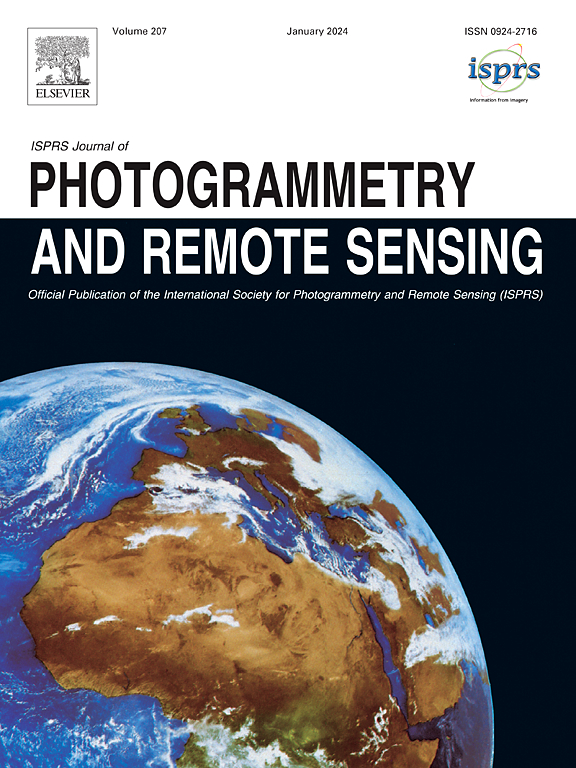STANet-TLA:利用深度学习和先验知识,从无人机时间序列数据中进行大规模大豆育种小区分割和高产品种筛选
IF 10.6
1区 地球科学
Q1 GEOGRAPHY, PHYSICAL
ISPRS Journal of Photogrammetry and Remote Sensing
Pub Date : 2025-06-25
DOI:10.1016/j.isprsjprs.2025.06.012
引用次数: 0
摘要
高产品种筛选是保障粮食安全的重要手段,需要在品种水平上监测林冠生长、提取动态性状和估算产量。无人机(UAV)提供了高分辨率时空数据的宝贵来源,可以加速情节水平的表型和品种筛选。然而,由于复杂的背景、动态的冠层以及不同的行间距和地块间距,从无人机图像中自动提取育种地块边界具有挑战性。在本研究中,我们介绍了一种名为STANet-TLA的新方法用于育种小区提取,以筛选高产品种。STANet-TLA利用自主设计的时空特征对齐网络(STANet)进行语义分割,利用先验知识约束牵引线聚合方法(TLA)进行实例分割。为了评估我们的模型,我们构建了一个名为SoyUAV的综合数据集,其中包括几乎所有生长阶段的超过977种基因型的21,319张图像。结果表明:(1)STANet在冠层语义分割上的IoU和F1-score分别达到85.43%和91.89%,优于8个最先进的深度学习网络,IoU和F1的平均提高分别为5.80%和4.65%。基于语义分割结果,TLA对图实例分割的IoU和F1分别达到了93.31%和95.13%;(2) STANet在不同年份、地点和数据类型之间具有有效的可转移性,IoU得分分别为88.22%、89.53%和79.16%。STANet-TLA适用于不同种植设计的地块实例分割;(3)在STANet-TLA分割得到的样地中,采用静态表型随机森林筛选高产品种的准确率为60%。当结合时间序列和动态拟合表型时,这种准确性分别提高到70.59%和75%。我们的数据集和模型是公开的,我们相信这将极大地促进先进的基于无人机的植物表型和广泛的大规模育种应用。本文章由计算机程序翻译,如有差异,请以英文原文为准。
STANet-TLA: leveraging deep learning and prior knowledge for large-scale soybean breeding plot segmentation and high-yielding variety screening from UAV time-series data
High-yielding varieties screening is essential for food security, which requires the monitoring of canopy growth, the extraction of dynamic traits, and the estimation of yield at the variety level. Unmanned Aerial Vehicle (UAV) provides a valuable source of high-resolution spatio-temporal data, which can accelerate plot-level phenotyping and variety screening. However, the automatic extraction of breeding plot boundaries from UAV images is challenging due to complex backgrounds, dynamic canopies, and varying row and plot intervals. In this study, we introduce a novel method called STANet-TLA for breeding plot extraction to screen high-yielding varieties. STANet-TLA leverages a self-designed spatio-temporal feature alignment network (STANet) for semantic segmentation and a prior knowledge-constrained traction line aggregation method (TLA) for instance segmentation. To evaluate our model, we constructed a comprehensive dataset named SoyUAV, which includes 21,319 images of more than 977 genotypes at almost all growth stages. The results demonstrated that: (1) STANet achieved an intersection over union (IoU) of 85.43 % and an F1-score (F1) of 91.89% for canopy semantic segmentation, outperforming eight state-of-the-art deep learning networks with average improvements of 5.80 % in IoU and 4.65 % in F1. Based on the semantic segmentation results, TLA achieved an IoU of 93.31 % and an F1 of 95.13 % for plot instance segmentation; (2) STANet demonstrated effective transferability across different years, locations, and data types, achieving high IoU scores of 88.22%, 89.53%, and 79.16%, respectively. STANet-TLA was suitable for plot instance segmentation with different planting designs; (3) The accuracy of high-yielding varieties screening was 60 % using Random Forest with static phenotypes in the plots obtained by STANet-TLA segmentation. This accuracy was improved to 70.59 % and 75 % when incorporating time-series and dynamic-fitting phenotypes, respectively. Our datasets and models are publicly available, which we believe will significantly facilitate advanced UAV-based plant phenotyping and widespread large-scale breeding applications.
求助全文
通过发布文献求助,成功后即可免费获取论文全文。
去求助
来源期刊

ISPRS Journal of Photogrammetry and Remote Sensing
工程技术-成像科学与照相技术
CiteScore
21.00
自引率
6.30%
发文量
273
审稿时长
40 days
期刊介绍:
The ISPRS Journal of Photogrammetry and Remote Sensing (P&RS) serves as the official journal of the International Society for Photogrammetry and Remote Sensing (ISPRS). It acts as a platform for scientists and professionals worldwide who are involved in various disciplines that utilize photogrammetry, remote sensing, spatial information systems, computer vision, and related fields. The journal aims to facilitate communication and dissemination of advancements in these disciplines, while also acting as a comprehensive source of reference and archive.
P&RS endeavors to publish high-quality, peer-reviewed research papers that are preferably original and have not been published before. These papers can cover scientific/research, technological development, or application/practical aspects. Additionally, the journal welcomes papers that are based on presentations from ISPRS meetings, as long as they are considered significant contributions to the aforementioned fields.
In particular, P&RS encourages the submission of papers that are of broad scientific interest, showcase innovative applications (especially in emerging fields), have an interdisciplinary focus, discuss topics that have received limited attention in P&RS or related journals, or explore new directions in scientific or professional realms. It is preferred that theoretical papers include practical applications, while papers focusing on systems and applications should include a theoretical background.
 求助内容:
求助内容: 应助结果提醒方式:
应助结果提醒方式:


